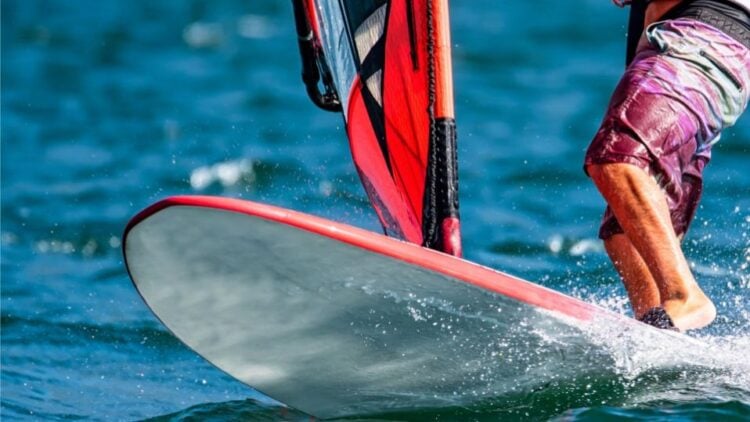
OBJECTIVE OF WINDSURFING: Traverse a water-based race course and be the first to cross the finish line.
NUMBER OF PLAYERS: 2+ players
MATERIALS: Windsurfing board, harness, wet suit, floatation vest, helmet
TYPE OF GAME: Sport
AUDIENCE: 8+
OVERVIEW OF WINDSURFING

Windsurfing, also referred to as “sailboarding” and “boardsailing,” is a water sport that combines some of the best elements of surfing and sailing. Windsurfing is incredibly popular as a recreational activity because of how accessible it is, with equipment costs being only a fraction of those of a sailing boat. Additionally, windsurf boards are easily controlled entirely with the sail and can be maneuvered in ways similar to a small surfboard.
The sport of windsurfing came about in the late 1960s with the invention of the patented “windsurfer” made by California native and aeronautical engineer Jim Drake. As a surfer, sailor, and skier, Drake created the windsurfer so he could experience the pleasures of sailing in a way that was as simplistic as skiing (hence the easy maneuverability and controls).
By the early 1980s, windsurfing’s popularity exploded in both Europe and North America, and it soon became the fastest-growing sport in the world. This popularity was so profound, in fact, that it led to windsurfing becoming an official Olympic sport in 1984, just 15 years after its inception!
Nowadays, windsurfing remains one of the most popular water sports in the world, especially in regions of the world with great surf and wind conditions (with Maui, Hawaii, often being considered the best). With many different disciplines and board types, there is an endless amount of variation in the competitive and recreational windsurfing international scenes.
SETUP
WINDSURFING EQUIPMENT
- Windsurfing Board: A 7- to 10-foot-long board similar to a surfboard. These come in many different sizes, weights, and materials. All boards are accompanied by a mast, sails, and one or more fins, all of which are used to control and maneuver the board.
- Harness: A harness connects the surfer to their board in case they fall off.
- Wet Suit: Tight-fitting full-body suits that help a surfer maintain a warm body temperature in colder waters.
- Floatation Vest: A life-jacket-like vest that helps the surfer float in case of an emergency.
- Helmet: While not required, most windsurfers wear helmets to avoid traumatic hits or cuts to the head that can result when trying to do stunts in rough waters.
TYPES OF BOARDS
There are at least eight different kinds of windsurf boards available. Each board type is specialized for certain events, activities, and the experience of the surfer. These eight board types include:
- Beginner Boards: Very wide boards that provide beginner surfers with plenty of stability.
- Free-Ride Boards: Boards purposed for recreational activity. These are made to move primarily in straight lines at high speeds.
- Racing Longboards: Internationally recognized boards used in most major racing events (including the Olympics).
- Wave Boards: Small, light, and very maneuverable boards that are best used for performing jumps on waves (similar to surfing).
- Speed Boards: Board made to be exceedingly narrow for achieving high speeds.
- Slalom Boards: Boards designed to be incredibly fast while still maintaining optimal maneuverability.
- Freestyle Boards: Very wide yet highly maneuverable boards used for freestyling tricks and stunts on flat water.
- Formula Boards: Boards used specifically for formula races.
GAMEPLAY

There are multiple disciplines of competitive windsurfing. While the main differentiator between these disciplines is the type of board being used, some are more akin to traditional sailing events, while others resemble a surfing event.
1) RACING EVENTS
Time-based races make up the majority of windsurfing competitions. This includes events such as Slalom, Formula, and RS:X. All of these races are formatted in ways similar to traditional sailing events, with races taking place on large bodies of open water.
The goal of each race is to reach the finish line in the least amount of time possible. To get to the finish line, competitors race toward large buoys called “marks”. Once they get to the mark, they have to “jibe” around it by circling it and heading to the next buoy. After the last mark is completed, the first sailor to cross the finish line (often marked by boats) wins.
Additionally, some competitions include “speedsailing” events, which involve competitors traversing a very simple course while trying to reach the fastest speed possible. In most cases, nothing matters in these races other than the top speed the board is able to reach, which can often exceed 40 knots (46+ mph)!
Check out this Slalom event to see how fast these windsurfers go!
2) POINT-BASED EVENTS
Points-based windsurfing disciplines include Wave and Freestyle events. Instead of racing to a finish line, these other events make use of the surfboard-like design of the windsurfing boards by having competitors complete stunts and tricks on flat (Freestyle) or wavy (Wave) waters.
Multiple competitors (usually just two) take turns performing jumps, spins, and flips for a panel of judges over a period of 10 to 20 minutes. The competitor with the two highest-scoring stunts when the clock expires wins.
TECHNIQUES
Windsurfing requires a combination of skills from both surfing and sailing, including the ability to master balance, wave riding, and aerial maneuvers, as well as understanding wind dynamics, sail control, and efficient board handling.
Key techniques include harnessing the wind power to propel the board, performing maneuvers like tacking (changing direction while facing into the wind) and jibing (changing direction with the wind behind), and mastering footwork and body positioning for stability and control.
Only the fins can control lateral resistance from the wind direction. Keep your feet next to the mast foot and this balance will help you control when you tilt your mast straight or your mast forward from its safety position. Remember that you control the sail, so do not allow the sail pull to move you around.
Keeping your principle works whilst sailing will help you keep control of your vessel. These principles can be taught at many windsurfing schools.
END OF GAME
Traditional racing events are decided by the order in which the competitors cross the finish line.
Speedsailing events rank sailors based entirely on the top speed they were able to achieve during their runs.
Points-based events, such as Wave and Freestyle, are won by the competitor who scores the most points off their tricks and stunts. For both events, only a competitor’s two best stunts are counted. The judging criterion differs slightly between Freestyle and Wave (as one only takes place on flat water). However, all stunts are scored mainly along the lines of difficulty, execution, creativity, combos, style, and height (for wave jumps).
- 30 GAMES TO PLAY OVER TEXT - April 22, 2024
- 20+ FREE PRINTABLE BABY SHOWER GAMES - April 16, 2024
- 20+ College Party Games for the Best Night Ever! - April 2, 2024